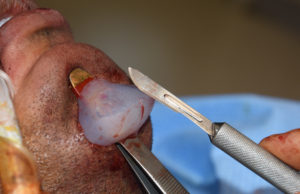A custom jawline implant design is based on an artistic and experienced assessment of the patient’s goals and what implant dimensions are felt that may accomplish them. It is not an exact science and can not calculate in how the overlying soft tissues will respond. This is relevant both aesthetically as well as potentially impacting soft tissue closure over the implant.
One area where the soft tissues over a custom jawline implant are of greatest relevance is that of the chin. The soft tissue pad of the chin is tight as it wraps around the end of the projecting chin bone. It can not stretch endlessly to fit over any size of the anterior chin portion of a jawline implant. Because a total jawline implant is connected from one end to the other, the influence of the chin size can be greater than one may think based on just projection numbers of the design alone.
In rare cases I occasionally have seen difficulties with the ability to close the submental incision over the chin portion of a custom jawline implant due to either too much horizontal, vertical or combined horizontal-vertical dimensions. This requires an intraoperative adjustment of the implant, which I do not like to do unless it is absolutely imperative that it is needed. Since the placement of a custom jawline implant requires passing it under the mental nerves, it is a good idea to not make that implant pass more times than one needs to do.

In situ implant adjustments are usually hard to do because working inside the tissue pocket is too restrictive. But a partial extraction of the implant makes it possible to make accurate intraoperative adjustments.
Dr. Barry Eppley
Indianapolis, Indiana


